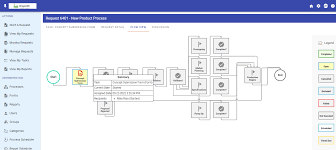The Power of Workflow Automation Software
In today’s fast-paced business environment, efficiency and productivity are key factors in staying competitive. Workflow automation software has emerged as a powerful tool to streamline processes, increase efficiency, and reduce human error in various industries.
Workflow automation software allows businesses to automate repetitive tasks, standardize processes, and improve overall workflow management. By automating routine tasks such as data entry, approvals, notifications, and document routing, organisations can save time and resources while ensuring consistency and accuracy.
One of the key benefits of workflow automation software is its ability to eliminate manual errors and inconsistencies. By setting predefined rules and workflows, businesses can ensure that tasks are completed correctly and on time, reducing the risk of costly mistakes.
Moreover, workflow automation software enables better visibility into processes by providing real-time insights and analytics. This allows businesses to identify bottlenecks, monitor performance metrics, and make data-driven decisions to optimise their operations.
Another advantage of workflow automation software is its scalability. As businesses grow and evolve, the software can easily adapt to changing needs by modifying workflows or adding new processes without significant disruptions.
Overall, workflow automation software empowers businesses to operate more efficiently, improve collaboration among teams, enhance customer satisfaction, and ultimately drive growth. By embracing automation technology, organisations can unlock their full potential and achieve greater success in today’s digital age.
Understanding Workflow Automation Software: Key FAQs for Businesses
- What is workflow automation software?
- How can workflow automation software benefit my business?
- What are the key features of workflow automation software?
- Is workflow automation software easy to implement and use?
- Can workflow automation software be customised to suit specific business needs?
- How does workflow automation software integrate with existing systems and tools?
What is workflow automation software?
Workflow automation software is a powerful tool designed to streamline and enhance business processes by automating repetitive tasks, standardising workflows, and improving overall efficiency. This software allows organisations to define, execute, and manage a sequence of tasks based on predefined rules and conditions. By automating routine processes such as data entry, approvals, notifications, and document routing, workflow automation software helps businesses save time, reduce errors, increase productivity, and gain better visibility into their operations. In essence, workflow automation software revolutionises how businesses manage their workflows by simplifying complex processes and enabling seamless collaboration across teams.
How can workflow automation software benefit my business?
Workflow automation software can benefit your business in numerous ways. By automating repetitive tasks and streamlining processes, it can significantly increase efficiency and productivity. This software helps reduce human error, ensures consistency in workflows, and saves time and resources by eliminating manual interventions. Additionally, workflow automation software provides better visibility into processes, enabling you to track performance metrics, identify bottlenecks, and make data-driven decisions to optimise operations. Ultimately, implementing workflow automation software can lead to improved workflow management, enhanced collaboration among teams, increased customer satisfaction, and overall business growth.
What are the key features of workflow automation software?
Workflow automation software offers a range of key features that empower businesses to streamline their processes and enhance efficiency. Some of the essential features include task automation, which allows for the automatic execution of repetitive tasks, reducing manual effort and human error. Workflow design tools enable users to create customised workflows tailored to their specific needs, ensuring seamless process management. Integration capabilities with other software systems facilitate smooth data exchange and communication across different platforms. Additionally, reporting and analytics functionalities provide valuable insights into workflow performance, enabling data-driven decision-making for continuous improvement. Overall, the key features of workflow automation software work together to optimise operations, increase productivity, and drive business success.
Is workflow automation software easy to implement and use?
Implementing and using workflow automation software can vary depending on the specific tool and the complexity of the processes being automated. Generally, many workflow automation software solutions are designed with user-friendly interfaces and intuitive features to facilitate easy implementation and use. With proper training and support from the software provider, businesses can quickly adapt to the new system and leverage its capabilities to streamline their workflows effectively. However, it is essential for organisations to invest time in understanding their unique requirements, customising the software to suit their needs, and providing adequate training to users to ensure a smooth transition and successful adoption of workflow automation software.
Can workflow automation software be customised to suit specific business needs?
Workflow automation software can indeed be customised to suit specific business needs. One of the key advantages of workflow automation solutions is their flexibility and adaptability to accommodate the unique requirements of different organisations. Businesses can tailor the software to align with their specific processes, workflows, and objectives by configuring custom rules, triggers, notifications, and integrations. This customisation capability allows businesses to maximise the benefits of workflow automation software by creating a solution that fits seamlessly into their existing operations and addresses their individual challenges and goals effectively.
How does workflow automation software integrate with existing systems and tools?
Workflow automation software offers seamless integration with existing systems and tools through various methods such as APIs, connectors, and plugins. These integration capabilities allow businesses to connect their workflow automation software with other applications, databases, and platforms used within their organisation. By leveraging these integration options, businesses can ensure smooth data flow between different systems, automate data exchange processes, and eliminate the need for manual data entry or duplication. This integration not only enhances efficiency but also enables businesses to maximise the value of their existing technology investments while streamlining their workflows for improved productivity and performance.

